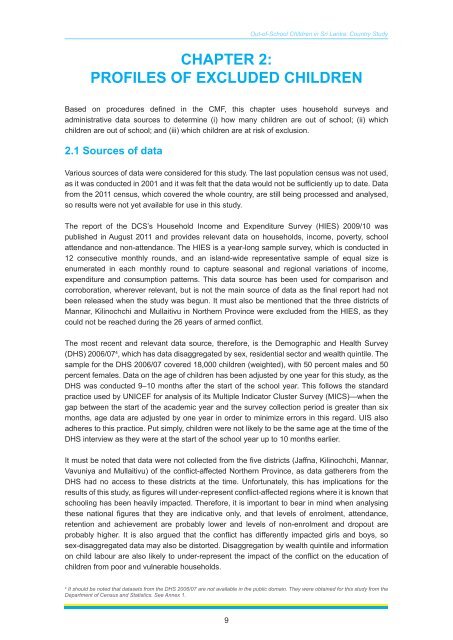Sri Lanka - Institut de statistique de l'Unesco
Sri Lanka - Institut de statistique de l'Unesco
Sri Lanka - Institut de statistique de l'Unesco
Create successful ePaper yourself
Turn your PDF publications into a flip-book with our unique Google optimized e-Paper software.
Out-of-School Children in <strong>Sri</strong> <strong>Lanka</strong>: Country Study<br />
CHAPTER 2:<br />
PROFILES OF EXCLUDED CHILDREN<br />
Based on procedures <strong>de</strong>fined in the CMF, this chapter uses household surveys and<br />
administrative data sources to <strong>de</strong>termine (i) how many children are out of school; (ii) which<br />
children are out of school; and (iii) which children are at risk of exclusion.<br />
2.1 Sources of data<br />
Various sources of data were consi<strong>de</strong>red for this study. The last population census was not used,<br />
as it was conducted in 2001 and it was felt that the data would not be sufficiently up to date. Data<br />
from the 2011 census, which covered the whole country, are still being processed and analysed,<br />
so results were not yet available for use in this study.<br />
The report of the DCS’s Household Income and Expenditure Survey (HIES) 2009/10 was<br />
published in August 2011 and provi<strong>de</strong>s relevant data on households, income, poverty, school<br />
attendance and non-attendance. The HIES is a year-long sample survey, which is conducted in<br />
12 consecutive monthly rounds, and an island-wi<strong>de</strong> representative sample of equal size is<br />
enumerated in each monthly round to capture seasonal and regional variations of income,<br />
expenditure and consumption patterns. This data source has been used for comparison and<br />
corroboration, wherever relevant, but is not the main source of data as the final report had not<br />
been released when the study was begun. It must also be mentioned that the three districts of<br />
Mannar, Kilinochchi and Mullaitivu in Northern Province were exclu<strong>de</strong>d from the HIES, as they<br />
could not be reached during the 26 years of armed conflict.<br />
The most recent and relevant data source, therefore, is the Demographic and Health Survey<br />
(DHS) 2006/07 4 , which has data disaggregated by sex, resi<strong>de</strong>ntial sector and wealth quintile. The<br />
sample for the DHS 2006/07 covered 18,000 children (weighted), with 50 percent males and 50<br />
percent females. Data on the age of children has been adjusted by one year for this study, as the<br />
DHS was conducted 9–10 months after the start of the school year. This follows the standard<br />
practice used by UNICEF for analysis of its Multiple Indicator Cluster Survey (MICS)—when the<br />
gap between the start of the aca<strong>de</strong>mic year and the survey collection period is greater than six<br />
months, age data are adjusted by one year in or<strong>de</strong>r to minimize errors in this regard. UIS also<br />
adheres to this practice. Put simply, children were not likely to be the same age at the time of the<br />
DHS interview as they were at the start of the school year up to 10 months earlier.<br />
It must be noted that data were not collected from the five districts (Jaffna, Kilinochchi, Mannar,<br />
Vavuniya and Mullaitivu) of the conflict-affected Northern Province, as data gatherers from the<br />
DHS had no access to these districts at the time. Unfortunately, this has implications for the<br />
results of this study, as figures will un<strong>de</strong>r-represent conflict-affected regions where it is known that<br />
schooling has been heavily impacted. Therefore, it is important to bear in mind when analysing<br />
these national figures that they are indicative only, and that levels of enrolment, attendance,<br />
retention and achievement are probably lower and levels of non-enrolment and dropout are<br />
probably higher. It is also argued that the conflict has differently impacted girls and boys, so<br />
sex-disaggregated data may also be distorted. Disaggregation by wealth quintile and information<br />
on child labour are also likely to un<strong>de</strong>r-represent the impact of the conflict on the education of<br />
children from poor and vulnerable households.<br />
4<br />
It should be noted that datasets from the DHS 2006/07 are not available in the public domain. They were obtained for this study from the<br />
Department of Census and Statistics. See Annex 1.<br />
9

















